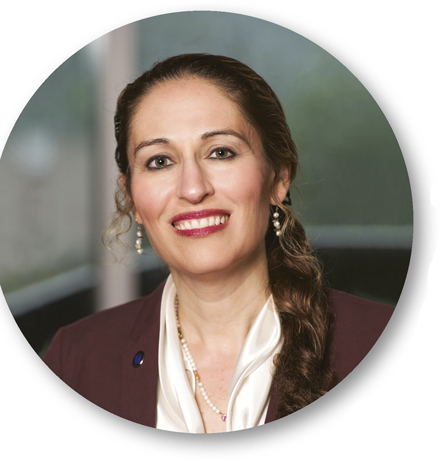The words “professor of physics” and “entrepreneur” rarely appear in the same sentence, let alone describe the same person. However, one of the first expressions that Christine Broadbridge, a professor of physics at Southern Connecticut State University (SCSU), used to describe herself was an “academic entrepreneur.” Over the past 25 years, Christine has built various programs that have established partnerships between industry and academic institutes to provide students in STEM with a wholesome learning experience. Amazingly, she has accomplished this while establishing research programs resulting in numerous publications and grant-funded initiatives.

As a first-generation college student in the 1980s, whose parents encouraged her to pursue a challenging career, Christine completed her undergraduate degree in electrical engineering at the University of Rhode Island (URI), followed by a Master’s degree and materials science-focused PhD degree in engineering at Brown University. “I was fortunate to learn about the rewarding aspects of engaging in STEM at an early age. While an undergraduate student, I sought out opportunities to engage in cutting-edge research while working with local companies,” she said. Although undergraduate research was considered unusual at that time, she was involved in one of the first industry/academic/government partnerships for the state: URI, Brown University, the State, and the jewelry industry. She recollected, “The experience was transformative, as I learned firsthand about research, scholarship, and the nature of science and technology. I found that I enjoyed the challenges but, more importantly, the application of knowledge to solve problems, with the ultimate goal of a beneficial impact on society.”
This resulted in the establishment of a surface science center, as well as Christine’s motivation for building more of such partnerships so that others could have the same transformative experience that had benefited her. “As soon as I started my career at Trinity College (around 1993), I started to build programs based on this very successful model,” she explained. In fact, her first venture was the establishment of United Technologies/Trinity College Engineering Initiative (UTCEI), an industry/academia partnership aimed at providing opportunities for research engagement to women and underrepresented groups in STEM.
Since then, Christine has worn many hats. She set up an electron microscopy lab at Trinity College in an effort to bring research, faculty, and undergraduate students together. These changes brought major developments in the research involvement of students as well as research accomplishments for Christine, garnering significant recognition and grant support. Before long, she realized that a move to New Haven-based SCSU, which had a strong Physics Department, had the potential for continued research and program development. This was the beginning of her collaboration with neighboring Yale University, which led to the establishment of the Center for Research on Interface Structures and Phenomena (CRISP), where she currently holds the title of education director.
As a National Science Foundation (NSF) Materials Research Science and Engineering Center (MRSEC), CRISP’s impact was tremendous. It resulted in world-class research and education, engaging thousands of students, teachers, and the public in cutting-edge interdisciplinary science and engineering. Christine’s academic entrepreneurship spirit continued to flourish as she took on the role of founding director of the Connecticut State Colleges and Universities’ Center for Nanotechnology and the SCSU Office for STEM Innovation and Leadership (STEM-IL). Most recently through STEM-IL, she established the BioScience Academic and Career Pathway Initiative (Bio-Path), an educational partnership between SCSU, the City of New Haven, and Connecticut’s BioScience industry.
Regarding challenges as a female leader in science, she said, “there definitely were obstacles of various kinds, but I always focused on the accomplishments of my students, and how I could make their learning experience meaningful. One of the most rewarding moments for me was when I came across a former female student who had participated in the UTCEI program, and who is now a researcher in the industry!” She explained that seeing the results of her work gives her the drive to keep moving forward.
Christine also mentioned how the Materials Research Society (MRS) has been a vital presence in her career growth. “I have always gone to every Fall MRS meeting, except for two, and that was when my two children were born,” she remarked with pride. MRS meetings steered her interest from electric engineering to device physics. While serving as the chair of the MRSEC Education Director’s Network, Christine’s involvement in MRS escalated to significant engagement in communication, diversity, and outreach committees. She helped organize MRS events that not only broadened participation in STEM from different groups, but also enhanced outreach in the community. “MRS is an ideal interdisciplinary platform that seeks to get students more involved in solving practical problems,” she mentioned.
Through raising her children, Christine has learned a lot about the country’s educational system for young people. “What excites me every day is to engage students in cutting-edge research and their real-world applications via internships with industry partners. The impact can be life changing, especially for students from underrepresented groups. I realized that during my undergrad experience, and started building programs based on that very successful model. Today, we know the importance of such programs, but I have been preparing my students in this manner since the 90s,” said Christine.


